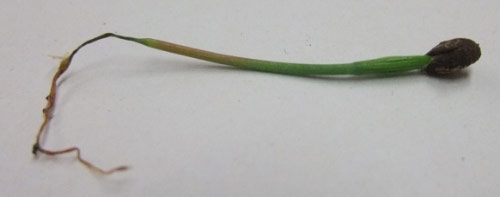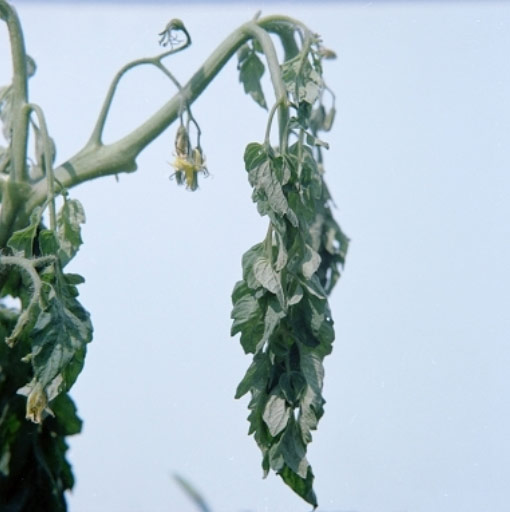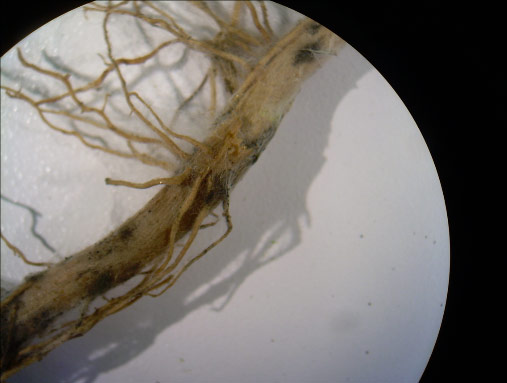Background:
Soil borne diseases are those plant diseases caused by pathogens who inoculate the host by way of the soil (as opposed to the air or water).1 Unhealthy soils can have issues with high levels of disease incidence and pests. Common soil borne diseases include damping-off, root rot and vascular wilt; and can exhibit symptoms such as tissue discoloration, wilting of foliage, root decay and sudden death.2 Soil-borne diseases can significantly reduce yields for many crops, and can decimate the agricultural sectors of large areas if not managed carefully.3
Pathogens, the biological agents responsible for soil borne diseases, are drawn from several taxonomic groups. The largest group are the fungi, but plant diseases can also be caused by bacteria, protozoa, viruses and nematodes.3-4 Under certain conditions, many of these disease causing organisms already exist in the soil in a non-pathogenic form. Other invasive organisms are only able to survive in the soil for a short amount of time after being introduced. In both cases, changes in soil factors such as pH, moisture, temperature and nutrient level can precipitate a disease outbreak.5 These changes can be a result of a shift in agricultural practices, introduction of new substances to the soil, or introduction of new crops.6
Management strategies such as ensuring well-drained, well-aerated fields; selection of disease-resistant plant varieties; and application of compounds such as copper sulfate can aid greatly in reducing soilborne disease incidence.7-10
Diagnosis:
Diagnosis of a soil borne disease can be difficult and normally relies on a combination of observed symptoms and prior knowledge of diseases common that may be an issue in your region. Comparing diseased and healthy plant samples by laboratory analysis can help to identify specific pathogens.
Symptoms to look for include:
- Leaf discoloration (yellowing, black spots)
- Stem discoloration (especially near the soil surface)
- Plant wilting
- Loss of vigour
- Stunting of growth
- Tissue distortion (oddly-shaped leaves, galls formed on stems)
Some common soilborne disease symptoms are outlined below:

Damping Off - Photo of a western pine seedling killed by damping off. Note the thinning of the stem at the base of the seedling, right at the level of the soil.
Root rot - Photo of Rhizoctonia root rot on corn. Note the black splotches on the root hairs.
Published under a Creative Commons License 3.0
https://upload.wikimedia.org/wikipedia/commons/f/f7/Rhizoctonia_Root_Rot_on_Corn.png
Taken from Rhizoctonia solani root rot on corn roots, magnified 0.63X. Identified using Barnett, H. L. & Hunter, B. B. (1998) Illustrated Genera of Imperfect Fungi. APS Press: St. Paul, MN; pp. 196–7 ISBN 0-89054-192-2.

Bacterial wilt - A tomato plant infected with Ralstonia solacenareum. Note the wilting stem and leaves.
Taken from
https://upload.wikimedia.org/wikipedia/commons/9/9a/Ralstonis_wilt_symptom.jpg
Management:
Below is a short summary of various management practices. For a full list of additional resources click here.
Controlling soil borne diseases requires knowledge of three main factors1:
- The pathogen at work
- The host plant being infected
- The soil conditions that allow that pathogen to flourish
The cost of a disease management strategy must also be less than the value of the crop saved for it to be economically viable. Factors such as disease severity, spread, and impact on yield need to be considered. Some strategies include:
- Minimize pest introduction - Careful selection of seed and soil amendments from reliable sources can reduce introduction of invasive pathogens. Carefully inspect seedlings and plant stock to ensure that they are disease-free before planting11.
- Disease-resistant cultivars - The “arms race” between plant breeders and the constant emergence of new pathogen strains has played a major role in keeping many soil borne diseases under control. Disease-resistant cultivars should be used when possible, as they can confer a long-lasting resistance to a particular pathogen genotype12.
- Chemical Controls- As fungi are one of the major causes of soil-borne diseases, fungicidal treatments such as copper sulfate and elemental sulfur can help control disease incidence in both seed stock and in the field. However, field-applied fungicide is not effective in all situations. Overapplication of copper and sulfur containing pesticides can have negative effects on the soil microbial community, and can cause heavy metal toxicity in some soils10.
- Reducing host-pathogen contact - For infection to occur, pathogens need to come into contact with the host plant. Host-pathogen interactions can be reduced through using disease-free fields, planning crop rotations of sufficient length to break pathogen cycles, ensuring proper drainage and aeration of soil, and through practices such as soil solarization. Plant resistance to infection can also be improved by careful fertilization, as nutrient-stressed or overly succulent plants can both be susceptible to disease7-9,13-15.
- Biological Controls - Biological control of soil diseases is a new and active area of research. Studies on the anti-pathogenic properties of cover crop and compost application, inoculation of soil with organisms to combat a specific pathogen, and the naturally occurring phenomena of disease-suppressive soils have all shown promising results16-18.
Resources:
Background on Soilborne Diseases
- An excellent guide to soil borne diseases in vegetables, including background on the ecology of soil borne pathogens, as well as short suggestions for treating a variety of diseases. https://anrcatalog.ucanr.edu/pdf/8099.pdf
- An open source article from the University of Karnataka, India, on some common soil borne diseases and strategies for management: http://www.rroij.com/open-access/soilborne-diseases-in-crop-plants-and-their-management.php?aid=33851
- A guide to managing soilborne diseases in organic vegetable production done by researchers from The Ohio State University https://articles.extension.org/pages/64951/soilborne-disease-management-in-organic-vegetable-production
- An outline of sustainable management strategies for soilborne diseases from the National Center for Appropriate Technology, including a section on using compost in disease suppression https://attra.ncat.org/attra-pub/viewhtml.php?id=283
- A summary of soil borne diseases and methods for management in Western Australia. Part of a larger soil management website and collection of resources. https://www.agric.wa.gov.au/diseases/soil-borne-diseases
- A short summary of soil borne plant diseases with a couple photos of mop-top disease in potato. Part of a larger website looking at the impact of the soil microbial community. http://www.fao.org/agriculture/crops/thematic-sitemap/theme/spi/soil-biodiversity/soil-organisms/the-function-of-the-soil-community/pests-diseases/en/
Specific soilborne disease management strategies
- A summary of pest management strategies organized by crop. The guidelines are specific to California and cover insect and disease management, but can be useful in a number of situations. https://www2.ipm.ucanr.edu/agriculture/
- A short presentation on how diseases can be transmitted through seed stock http://vegetablemdonline.ppath.cornell.edu/NewsArticles/Seed%20Infection%20and%20Transmission.pdf
- Overview of disease resistance in tomato and capsicum plants from the University of Florida http://ipm.ifas.ufl.edu/pdfs/Resistance.pdf
- Overall guidelines for fungicide application from Iowa State University https://hortnews.extension.iastate.edu/2018/07/fungicides-and-how-use-them-effectively
- Diagnosing plant diseases - fungal, viral or bacterial - from Michigan State University http://msue.anr.msu.edu/news/signs_and_symptoms_of_plant_disease_is_it_fungal_viral_or_bacterial
- An open-source review from researchers at the University of Malaga, Spain, on how organic soil amendments affect the soil microbial community and may contribute to disease suppression http://www.mdpi.com/1424-2818/4/4/475/pdf
- An open source book chapter outlining the principles behind disease suppressive soils, and how they can be used in agricultural systems https://www.researchgate.net/publication/232957603_Suppressive_Soils_in_Plant_Disease_Management?enrichId=rgreq-ceba0c52a7b62a9241dad6118c4b94ef-XXX&enrichSource=Y292ZXJQYWdlOzIzMjk1NzYwMztBUzo5OTg2NzMyMTk2MjUwMkAxNDAwODIxNjMzMzg3&el=1_x_3&_esc=publicationCoverPdf
- A guide to soil solarization produced by the University of California ANR https://ucanr.edu/sites/Solarization/
- An article by the Sustainable Agriculture Research and Education Center on how cover crops contribute to disease suppression in soils https://www.southernsare.org/News-and-Media/Regional-Resources/Regional-Bulletins/Cover-Crops-Research-Across-the-Southern-Region/Soil-Biology-Cover-Crops-and-Disease-Suppression
- An open source article on the mechanisms of disease suppression in soil through compost addition http://www.compost.org/CCC_Science_Web_Site/pdf/Disease%20Suppression/Supression%20of%20Plant%20Dieseases%20by%20COmpost.pdf
- A look at the relationship between soil management and disease suppressive soils in Sweden https://stud.epsilon.slu.se/8898/1/lobmann_m_160304.pdf
References
- Koike, S., et al. Vegetable diseases caused by soilborne pathogens. UCANR Publications, 2003.
- Hornby, D. (1998). Diseases caused by soilborne pathogens. In The Epidemiology of Plant Diseases (pp. 308-322). Springer, Dordrecht.
- Strange, Richard N., and Peter R. Scott. "Plant disease: a threat to global food security." Annu. Rev. Phytopathol. 43 (2005): 83-116.
- Sherf, A.F., MacNab, A.A., 1986. Vegetable Diseases and Their Control. Wiley, New York, 728 pp.
- You, Ming P., et al. "Modeling Effects of Temperature, Soil, Moisture, Nutrition and Variety As Determinants of Severity of Pythium Damping-Off and Root Disease in Subterranean Clover." Frontiers in microbiology 8 (2017): 2223.
- Mills, Katherine E., and James D. Bever. "Maintenance of diversity within plant communities: soil pathogens as agents of negative feedback." Ecology 79.5 (1998): 1595-1601.
- Subbarao, K. V., J. C. Hubbard, and K. F. Schulbach. "Comparison of lettuce diseases and yield under subsurface drip and furrow irrigation." Phytopathology 87.8 (1997): 877-883.
- Hao, Jianjun, Krishna V. Subbarao, and Steven T. Koike. "Effects of broccoli rotation on lettuce drop caused by Sclerotinia minor and on the population density of sclerotia in soil." Plant Disease 87.2 (2003): 159-166.
- Baysal, Fulya, et al. "Field management effects on damping-off and early season vigor of crops in a transitional organic cropping system." Phytopathology 98.5 (2008): 562-570.
- Wang, Quan-Ying, Dong-Mei Zhou, and Long Cang. "Microbial and enzyme properties of apple orchard soil as affected by long-term application of copper fungicide." Soil Biology and Biochemistry 41.7 (2009):1504-1509.
- Hebbar, K. P., et al. "Pseudomonas cepacia, a potential suppressor of maize soil-borne diseases—seed inoculation and maize root colonization." Soil Biology and Biochemistry 24.10 (1992): 999-1007.
- Nelson, Rebecca, et al. "Navigating complexity to breed disease-resistant crops." Nature Reviews Genetics 19.1 (2018): 21.
- Abawi, G. S., and T. L. Widmer. "Impact of soil health management practices on soilborne pathogens, nematodes and root diseases of vegetable crops." Applied soil ecology 15.1 (2000): 37-47.
- Bailey, K. L., & Lazarovits, G. (2003). Suppressing soil-borne diseases with residue management and organic amendments. Soil and tillage research, 72(2), 169-180.
- 1Peralta, A. L., Sun, Y., McDaniel, M. D., & Lennon, J. T. (2018). Crop rotational diversity increases disease suppressive capacity of soil microbiomes. Ecosphere, 9(5), e02235.
- Raaijmakers JM, Mazzola M. Soil immune responses. Science. 2016;352(6292):1392–3. pmid:27313024
- 1Bakker, Peter AHM, et al. "The soil-borne legacy." Cell 172.6 (2018): 1178-1180.
- Bonanomi, G., Lorito, M., Vinale, F., & Woo, S. L. (2018). Organic Amendments, Beneficial Microbes, and Soil Microbiota: Toward a Unified Framework for Disease Suppression. Annual review of phytopathology, (0).

